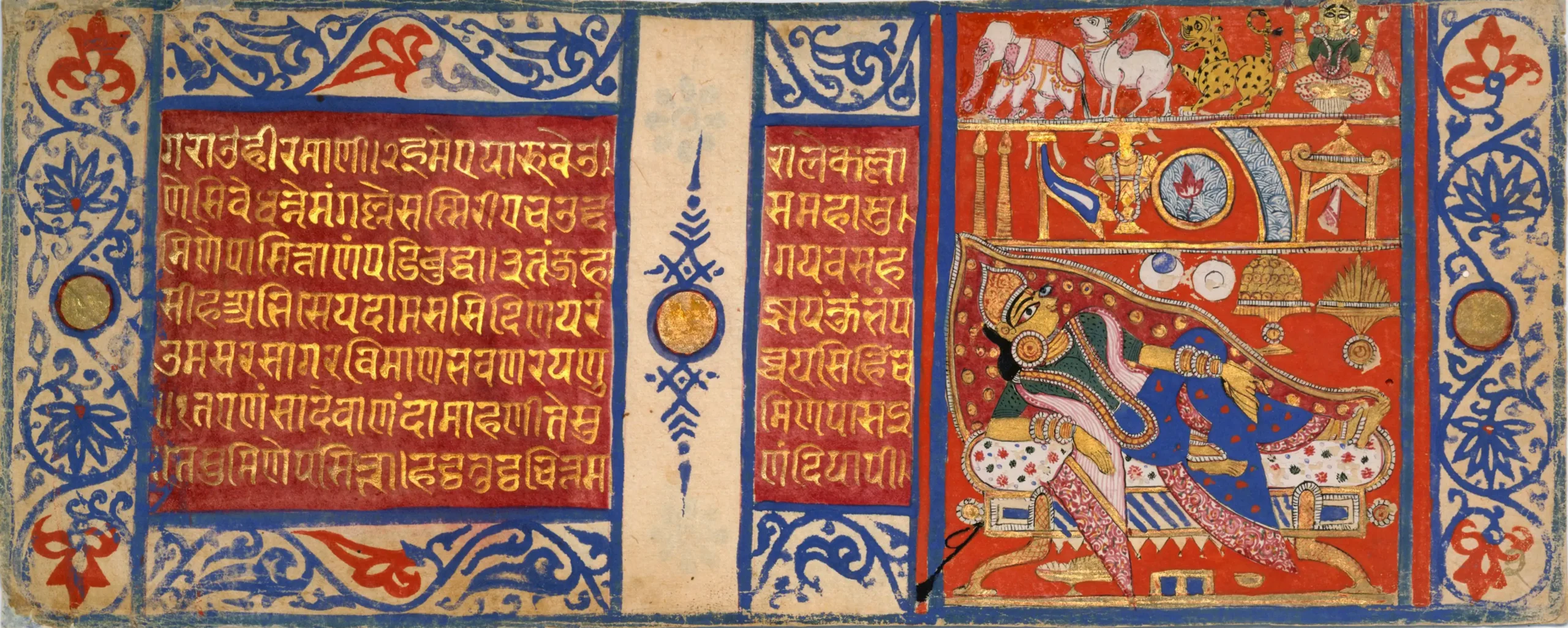Miniature Painting That Shaped a Tradition
Jain Manuscript paintings are miniature paintings that began as small illustrations used to embellish sacred Jaina literature. They may fit in the palm of your hand, yet they open up entire worlds of devotion, storytelling, and artistic invention. Originally created to embellish sacred texts, these miniatures gave birth to the Western Indian painting tradition—a style celebrated worldwide for its bold lines, saturated colours, and dramatic storytelling. Despite their size, the paintings burst with energy, turning even the smallest folio into a stage for grand narratives.
While Jain art also thrived in temple murals and cloth paintings, it is the miniature works on palm leaves and paper that have endured for nearly a thousand years, keeping alive legends from India’s ancient past.
From Oral Tradition to Manuscript
Jainism, one of India’s three classical religions alongside Hinduism and Buddhism, began as an oral tradition. But when a famine in the 5th century threatened to erase this heritage, a solution emerged: writing and illustrating the teachings. The lives and lessons of the Jinas were preserved in words and images, copied onto manuscripts for posterity.
Patronage flowed from both rulers, such as the Solanki king Kumarapala, and wealthy merchants who commissioned manuscripts as acts of devotion. They were reposited at temple libraries or bhandaras. The worship (jnanapuja) and study (svadhyaya) of these books became an integral part of Jain rituals.
Centres of Production
The production of Jain manuscript paintings was concentrated in Gujarat and Western Rajasthan, with workshops in Patan and Ahmedabad taking centre stage. Yoginipur and Jaunpur in North India, as well as Mandu in Central India, were also prolific producers of fine manuscripts. South India also presents a few Digambar Jain manuscripts, such as the Dhavala and Mahadhavala.
The earliest miniature extant is believed to be the Nisithachurni manuscript, dated to 1100 CE; however, it is certain that the art of manuscript illustration existed as far back as the art of writing itself.
Two Phases of Production
According to Umakant P. Shah, Jain manuscript painting can be categorised into two phases:
- Palm-leaf period (1100–1350 CE): The base material was birch bark (bhurjapatra) or palm leaves (taadpatra). Narrow leaves formed the folios of the book. After the text was transcribed, the manuscript was handed to the painter. The folios were then bound with decorated wooden covers called kastha pattika.
- Paper period (from mid-14th century ): The introduction of paper brought subtle changes in technique without altering the spirit of expression. Artists gained more space to work with, though the traditional horizontal format of around 10 × 20 cm persisted. The quaint fashion of marking string-holes also continued even when binding was no longer in use.
Texts and Themes
Jain manuscript paintings were essentially didactic in nature. The two principal texts of the Svetambara Jains—the Kalpasutras and Kalakacharyakatha—were recurring themes. Other manuscripts elaborated on these, such as Neminatha-charita, Parsvanatha-charita, and Trisastisalakapurushacharita.
In Jain tradition, the lives of the Tirthankaras unfold around five great milestones, known as the pañcakalyanaka.
It begins with Garbha, the moment of conception, when the mother of the Tirthankara dreams 14 wondrous and auspicious visions that foretell the birth of a spiritual saviour. Janma, the joyous arrival of the child into the world, follows this event.
As the Tirthankara grows, the call of renunciation comes—Dikṣā, the initiation into monastic life, marking the turning away from worldly ties. In time, the seeker attains Jñāna, the supreme kevala-knowledge, that reveals all truth, past, present, and future. The journey culminates in Mokṣa, final liberation, when the soul is freed from the cycle of birth and death.
Manuscripts often preserve not only these five events but also the names of the Tirthankaras’ family members. Among them all, it is Mahavira’s life that is told with great detail, his story unfolding with a richness unmatched by the rest.
Style and Form
By the 14th century, the stylistic conventions of this tradition had become firmly established. Eschewing the 3D modelling of classical Ajanta paintings, they embraced linearity and stylisation. Compositions grew increasingly complex in the second phase, with folios divided into panels to accommodate action-filled scenes in as little as 5 × 8 cm of space.
Figures became angular and dynamic, with bold, fluid lines that added to their impact. Distinctive features included wide fish-shaped eyes, pointed noses and chins, and torsos with narrow waists and prominent chests. Long, tapering fingers were held in elegant mudras. The careful rendering of textiles makes these paintings an invaluable source for India’s rich textile heritage.
The colour palette, though limited, was robust—red, yellow, blue, green, white, and black filled with thick washes of saturated intensity. Figures were often painted with yellow carnation, and outlines limned in red or black.
The Persian Touch
The 15th century brought contact with Islamic culture, which enriched Jain painting in exciting ways. Paper replaced palm leaves, compositions grew more elaborate, and artists introduced arabesque borders, floral motifs, and luxurious pigments like ultramarine, carmine, gold, and silver. Gold, earlier used only as highlights, was now applied generously, adding opulence to the visual language.
A Lasting Legacy
Rooted in the mural traditions of Ellora and Sittanavasal, Jain miniatures carved their own path, departed radically from the lyrical spirituality of classical art. Their earthy and bold style influenced the Chaurapancasika style, the later Rajasthani and Deccan schools, and even art across Asia.
- Chandra, M., 1974. Studies in early Indian painting. New York : Asia Pub. House.
- Guy, J., 1982. Palm-leaf and paper: Illustrated manuscripts of India and Southeast Asia. National Gallery of Victoria, Melbourne
- Pal, P. (Ed.), 1994. The Peaceful Liberators: Jain Art from India. Thames & Hudson, New York : Los Angeles, Calif.
- Shah, U.P., and Kalyan K. Ganguli, editors, 1966. Western Indian Art: Journal of The Indian Society of Oriental Art, Special Number, First Edition / First Printing edition. ed. The Indian Society of Oriental Art..
- Tripathi, Satyavrat, and Jain, Pawan, 2019. Kaivalyam. New Delhi.
- http://www.metmuseum.org/toah/hd/jaim/hd_jaim.html
- http://www.jainpedia.org/manuscripts/jainpedia-manuscripts.html






